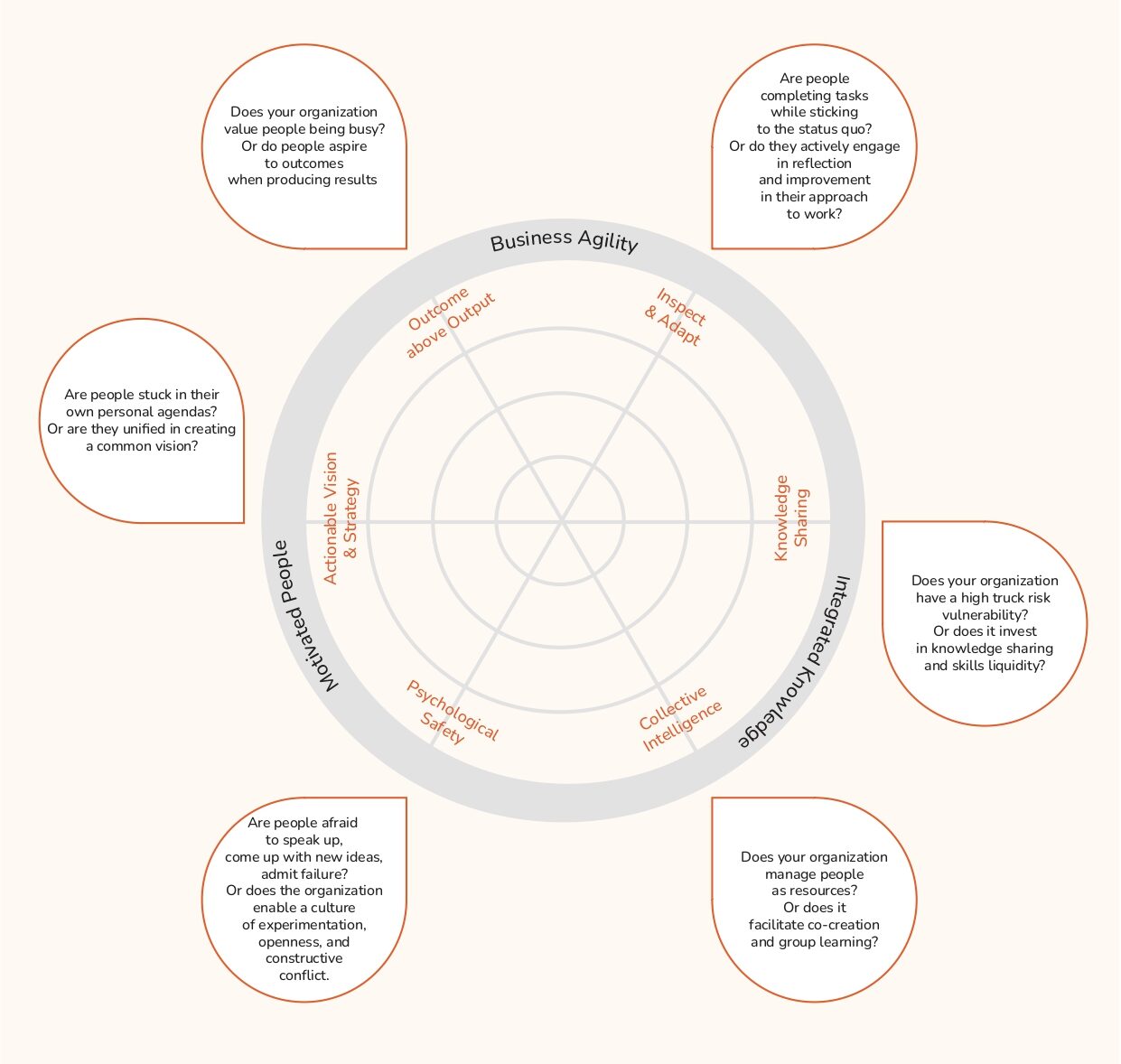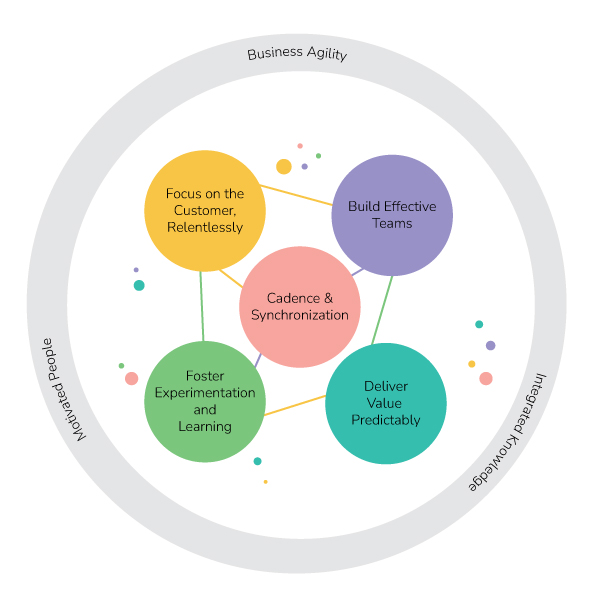The evolution of agile methodologies has been remarkable. While frameworks or methods such as Scrum, Kanban, and others are widely used, there’s a rising need for strategic, or business, agility beyond the mere tactical execution of agile concepts.
The Business Agility Institute states: “Business Agility is the willingness and capacity of an organization to adapt to create, and leverage change for their customer’s benefit.”
In simpler terms: it’s an organization’s ability to synchronize with the evolving needs of its customers.But what does that mean? And how do you get there?
Our managing partners Kris and Vincent elaborate!
Do you already know what strategic / business agility is? Then skip this next part and go straight to our Business Agility model!
Tactical vs. strategic agility
Before we go any further on why we think you should invest in strategic agility, let’s take a look at the difference between tactical and strategic agile.
So, let’s play ping-pong!
Kris: “On a tactical level, a ping-pong game itself is the key focus. How can you win THIS game? By using your best technique and manipulating the game a certain way so you can always play, let’s say, with your superior forehand.”
“But after this game, another one comes. And another one. And one day, you might want to win the World Championship. But by always focusing on one game at a time, playing only with your forehand, you won’t get far. So you switch to strategic thinking: what do you need to do in order to eventually win the championship? You will need to force yourself to play backhand, and get better at it.”
And that’s the same within your business. Where do you want to be in two, three, maybe five years? Do you want to keep producing the same product? Delivering the same one-off service? Or do you want to fulfill a certain mission that aligns with what your customers need? What action will you take today, for tomorrow? That’s strategic thinking.
Don’t get us wrong: tactical thinking isn’t bad. You do need both tactical and strategic thinking to get that real, impactful agile change. Both on short-term and long-term. Everything needs to be aligned, from the top of your company to the bottom and across.
Why shift to strategic agile?
Vincent: “The shift towards strategic agile thinking is something we already see within the community, and we often hear it from our clients. Managers and company leaders who have implemented agile practices feel they need to shift gears to a higher level. And they are often relieved when they hear us talking about strategic agility. Suddenly, it makes sense.”
“Because when we see agile implementations fail in companies, it’s always for the same reason. Agile is still considered an instrument, a tangible tool, that needs to be implemented to make the business agile. This operational, tactical way of looking at agile doesn’t work. To really focus on company strategy and your customer’s needs, you need to step away from “How successful are all teams implementing Scrum properly?” and go to “Am I efficient in delivering the right thing?”. Does it solve a client’s problem and bring them satisfaction? Is it aligned with the company’s strategy?”. This implies shortening the feedback loops on all levels (teams, value streams, portfolio), aligning them with each other and closing each loop properly. There is no learning in starting feedback loops, without studying and acting on the feedback. Achieving that mindset would mean an acceleration of the business but also of your people.”
What it means to shift your team
Within the shift towards strategic agility, you need people who consider the challenge first, and their expertise second. By thinking “What do we need to solve this challenge?”, you automatically generate more ideas and discover new competencies, close to the skills you already have. So you also need to shift your team and people. But what does that mean?
Kris: “The success of an organization depends on its ability to fulfill their customer’s needs. When these needs change, the company must be able to identify those changes and act upon them without hesitation. The internal structures of an organization, however, can’t change at the same pace. Organizational structures are more rigid and are hard to change at the same pace the business wants to innovate.”
“In order to not limit the flexibility of the business, the teams must learn how to absorb these changes without the need to change the team structure itself. So you create teams that embrace a problem-solving mindset rather than a skill-based way of working. The implemented core structure will then guide and support the team when it’s time to switch things up to solve a client’s challenge.”
How to shift to strategic agile?
Okay, so it’s clear you need to shift gears and invest in strategic or ‘business’ agility. But how do you do that?
To help companies and their people with this new way of working and thinking, we developed a model that looks at agile change from 3 key pillars:
- Business agility
- Integrated knowledge
- Motivated people
This maps perfectly to the earlier definition: “Business Agility is the willingness (= motivated people) and capacity (=integrated knowledge) of an organization to adapt to create, and leverage change for their customer’s benefit.”
On the next level (inside circle), we look at 6 desired outcomes:
- Inspect & adapt
- Knowledge sharing
- Collective intelligence
- Psychological safety
- Actionable vision & strategy
- Outcome above output

To achieve these outcomes, we train and coach according to 5 disciplines that are all connected.
- Build effective teams
Design and develop value-oriented teams that are self-regulating and autonomous. Support them in developing their shared purpose, aligned with the organization’s business strategy and vision. Make sure that team structures have as little dependencies as possible. - Deliver value predictably
This is all about optimizing flow and predictability of the way of working. What are bottlenecks? Where do we waste time? How many things are happening simultaneously? How long does it take to deliver real customer value? Can we predict our workload? Are we working on the right things? - Relentless customer focus
Always focus on the customer. Who are your clients, and what do they need? What are their obstacles? Take the time to validate the assumptions you have on these questions, and really get to know your customer. Develop a discovery and customer collaboration mindset.

- Foster Experimentation and Learning
How can you experiment to generate new ideas and continuously learn about your own processes and the client’s needs? It’s a tough one because it demands psychological safety to “dare to fail”, from both the company and the people in the team. Remember: growth is not achieved within your comfort zone.
- Cadence & synchronization
For iLean, that’s the heart of everything – that’s why we put it in the middle. 😉
The cadence is the rhythm of the things you do, in a daily, monthly, quarterly, or yearly cycle. It all needs to be aligned. Does it make sense if your biweekly development sprints are not aligned with your business plan? The actions of today need to make sense in the long-term vision and strategy.
Using this model, we will help you connect the agile change of your teams to your business strategy.
We hope this has shed some light on our vision for agile change and how to really make an impact with strategic agility.
What are your thoughts on this vision? Let’s discuss!



